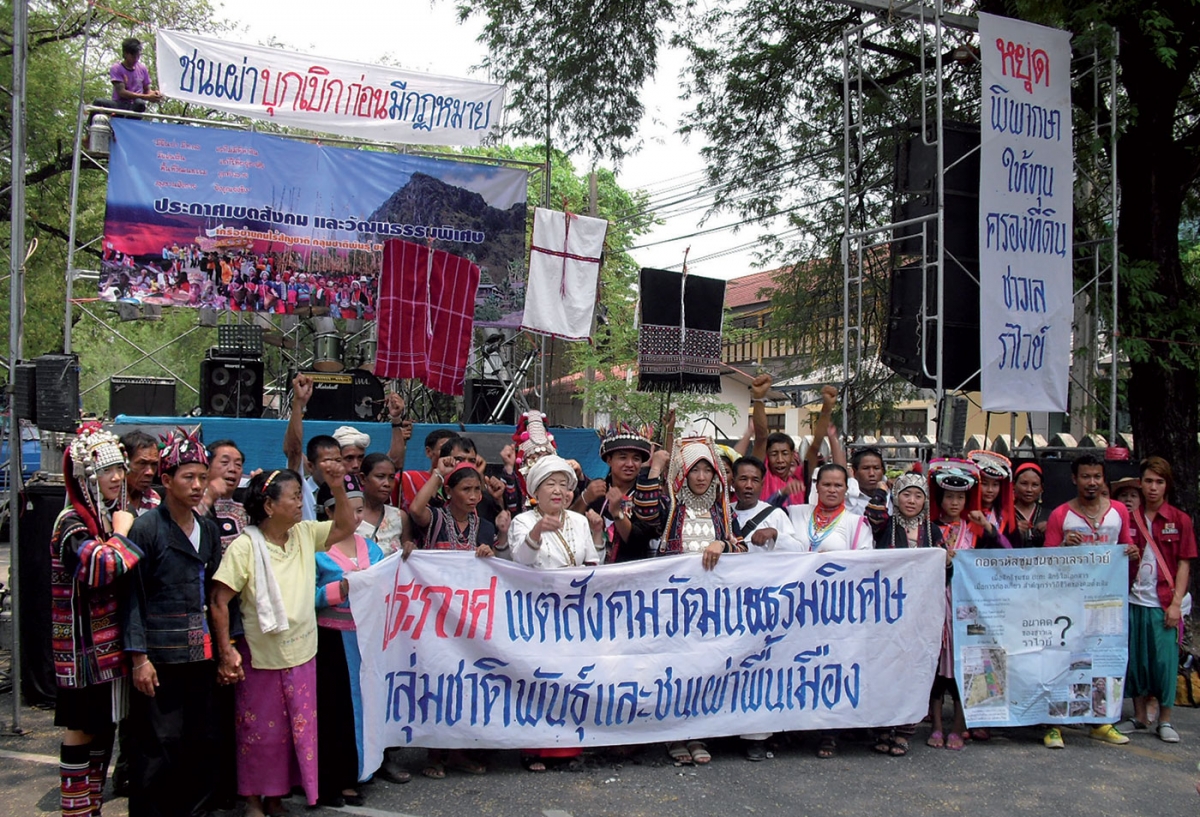Indigenous Peoples' shifting engagements with the Thai state
<p>Since the early 2000s a coalition of ethnic minorities in Thailand has promoted a sub-national social movement under the global banner of ‘Indigenous Peoples’. Initiated by leaders of the 10 so-called ‘hill tribes’ in the North, the movement has since expanded to include representatives of an additional 30 ethnic groups from within and beyond the North. Recent estimates place Thailand’s populations of ‘hill tribes’ at 1.2 million people and lowland ethnic groups at 4.9 million people. The expanding Indigenous movement thus has the potential to represent some 6.1 million people, comprising 9 percent of Thailand’s total population of roughly 68 million people. </p>
The Indigenous movement in Thailand officially began in August 2007 when a coalition of grassroots organizations representing 24 ethnic groups organized Thailand’s first annual ‘Festival of Indigenous Peoples in Thailand’ on the occasion of the International Day of the World’s Indigenous Peoples. At a follow-up event to the festival in the same year, the Network of Indigenous Peoples of Thailand (NIPT) was established. Its goals were to campaign via public demonstrations, media campaigns, and bureaucratic lobbying for legal recognition of Indigenous Peoples by the Thai state in order to gain and protect their basic rights to citizenship, land, and their distinct identities. The Indigenous movement emerged during a period in Thailand when the state, at least rhetorically speaking, was striving to reframe the nation in a multicultural rather than mono-cultural fashion. The movement has been variably supported and obstructed by the Thai state; supported because of the state’s new multicultural rhetoric yet obstructed because of the state’s top-down approach to multiculturalism.
In recent years the Indigenous movement has shifted its strategies away from public demonstrations towards independent media productions and bureaucratic lobbying. Between 2014-2016, the movement especially worked to establish direct ties with state agencies overseeing the review of national legislation and the constitutional reform process initiated by the current military regime. It has further decided to focus its limited time and resources on lobbying for the passage of a state law governing the ‘Council of Indigenous Peoples in Thailand’ (CIPT), a new, independent quasi-state organ comprised of Indigenous representatives with the central mandate to advise the state on policies and plans of relevance to Indigenous Peoples.
Since November 2014 the NIPT has lobbied several state agencies, including the Prime Minister’s Office, for advice and support in its efforts to have the military-appointed National Legislative Assembly (NLA) review its draft legislation governing the CIPT. The NIPT was eventually successful in having the draft legislation forwarded to the NLA in July 2015. As of early October 2016, however, the NLA had yet to review the legislation due to its concern with other matters deemed more pressing.
Between November 2014 and March 2016, the NIPT further lobbied for, first, official recognition of Indigenous Peoples in Thailand, and, second, legal recognition of the CIPT in each of the two successive constitutional drafts drawn up by different military-appointed Constitutional Drafting Committees. The NIPT eventually gained official recognition of Indigenous Peoples in the first constitutional draft released to the public in April 2015. Its success was, however, short-lived, as just five months later, on 6 September 2015, the military-appointed National Reform Council rejected that first draft. The second and final constitutional draft, which was released to the public in March 2016 and ratified via national referendum on 7 August 2016, did not include any reference to ‘Indigenous Peoples’ whatsoever. Regardless, the NIPT’s success in gaining recognition of Indigenous Peoples in the first draft of the constitution was significant given the Thai state’s longstanding stance of non-recognition of Indigenous Peoples.
Despite constitutional and legal setbacks the NIPT has moved forward independently of the state in bringing its vision of the CIPT to fruition. On 9 August 2015, the NIPT publicly declared the CIPT to be fully functioning with 190 representatives from 38 different Indigenous groups (five representatives per group) and two sub-national level Indigenous Councils. As of early November 2016, 40 different Indigenous groups and three sub-national Indigenous Councils were affiliated with the CIPT. The membership has expanded such that the CIPT has administratively divided its constituents into five geographical regions—the upland North, the lowland North, the Northeast, the east and west of Central Thailand, and the South. At present, however, the movement faces the problem of insufficient funding to take these developments forward in an expeditious manner without losing its current momentum.
Official state recognition of Indigenous Peoples in Thailand seems highly unlikely in the near future given both a long history of non-recognition and the current military regime’s renewed focus on nation building in a mono-ethnic fashion, centralizing state power and budgets, and national security issues in relation to which upland Indigenous Peoples have long been held suspect. In this political climate any claims for state recognition as a distinct group within the larger Thai nation are likely to fall on deaf ears at best, and, at worst, evoke suspicions of separatism as in the case of the far South and, more recently, the North and Northeast. Meanwhile, the grassroots Indigenous movement has expanded to become a national movement potentially representing some 6.1 million people. The Thai government has accordingly paid ever greater attention to the movement and provided certain opportunities for its growth, albeit largely on the state’s terms.
Micah F. Morton, Associate Fellow, ISEAS – Yusof Ishak Institute, Singapore (morton.micah@gmail.com).
For more in-depth analyses of the emerging politics of Indigeneity in contemporary Thailand see Morton, Micah F. 2016. 'The Indigenous Peoples’ Movement in Thailand Expands'. Institute of Southeast Asian Studies Perspective 68:1-12; Baird, Ian G., P. Leepreecha & U. Yangcheepsujarit. 2017. 'Who should be considered “Indigenous”? A survey of ethnic groups in northern Thailand’. Asian Ethnicity 18(4):543-62.
